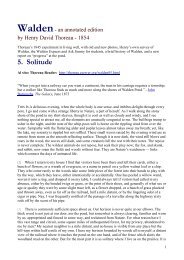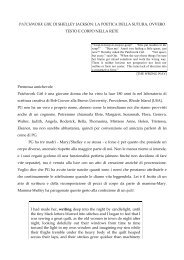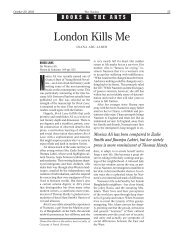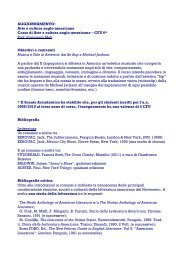Rewriting Woolf s Mrs. Dalloway: Homage, Sexual ... - Paola Carbone
Rewriting Woolf s Mrs. Dalloway: Homage, Sexual ... - Paola Carbone
Rewriting Woolf s Mrs. Dalloway: Homage, Sexual ... - Paola Carbone
You also want an ePaper? Increase the reach of your titles
YUMPU automatically turns print PDFs into web optimized ePapers that Google loves.
Clarissa Vaughan to live a domestic and sexual life largely unavailable to Clarissa<strong>Dalloway</strong> in 1920s London. As Patricia Cramer observes,Virginia <strong>Woolf</strong> grew up at a time when tolerance of public expressions ofromantic bonds between women had ended; for the first time, legal and medicalauthorities recognized the sexual potential in such relationships and scrutinizedthem for signs of 'perversion.' Sexologists Richard von Krafft-Ebing andHavelock Ellis propagated the stereotype of the mannish lesbian, and SigmundFreud declared erotic attachments between women a mental illness. (118)Because of the cultural climate, <strong>Woolf</strong> was compelled to live a relatively secretand encoded sexual existence, and her character Clarissa <strong>Dalloway</strong>, whose sexualorientation would appear to be largely toward women, ends up in a ratherchaste, heterosexual marriage that crushes her soul. Although Cunningham'sClarissa Vaughan is free to live openly as a lesbian, her interior life is neverthelessplagued by similar regrets and uncertainties about decisions she hasmade: "How often since then has she wondered what might have happened ifshe'd tried to remain with [Richard]; if she'd returned Richard's kiss on the cornerof Bleecker and MacDougal, gone off somewhere (where?) with him, [. . .]Couldn't they have discovered something . . . larger and stranger than whatthey've got?" {The Hours 97).Although I do not believe Cunningham is suggesting that it does not matterhow Clarissa orients herself sexually—clearly it seems wiser to construct a sexualand domestic identity that satisfies one's desires and instincts—he indicatesthat even if she were to live an openly gay existence, she would continue toexperience doubts. In demonstrating that her life, whether as a lesbian or heterosexual,would be more similar than different, Cunningham suggests thatstrict demarcations between queer and straight are problematic and that sexualorientation is complex and fluid. In The Hours, men and women desire touchand contact with one another and that desire often transcends or contradicts thenarrow identity labels, via sexual orientation, that society has constructed.In the novel's second narrative strand, "<strong>Mrs</strong>. Brown," Laura Brown appearsnear-desperate in her desire to escape her roles as housewife and mother in a LosAngeles suburb. Here, the dialogue with <strong>Woolf</strong> continues. Laura's first name isderived from <strong>Woolf</strong>'s half-sister who, Cunningham explains, "was just squirreledaway and was really not spoken of. [...] rather like Mr. Rochester's wife in JaneEyre" (Schiff, "Interview" 118). Her surname comes from <strong>Woolf</strong>'s well-knownessay, "Mr. Bennett and <strong>Mrs</strong>. Brown," in which the latter is the name given to anunknown woman spotted in a railway carriage who serves as the inspiration fora literary character; <strong>Mrs</strong>. Brown, thus, represents the artist's ability to imaginethe lives of others.^ The relationship between Laura Brown and <strong>Woolf</strong> developsthrough Laura's reading of <strong>Mrs</strong>. <strong>Dalloway</strong>, which enables her to escape into aparallel world: "[S]he has left her own world and entered the realm of the book"{The Hours 150), where she is "herself and not herself. She is a woman in London,an aristocrat, pale and charming, a little false; she is Virginia <strong>Woolf</strong>; and she368 CRITIQUE








